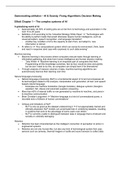Samenvatting
Summary All articles - AI & Society: Fixing Algorithmic Decision Making (S_AIS)
- Instelling
- Vrije Universiteit Amsterdam (VU)
All the articles you need for the midterm exam. I also uploaded the complete lecture notes, don't forget to check those out too!
[Meer zien]




